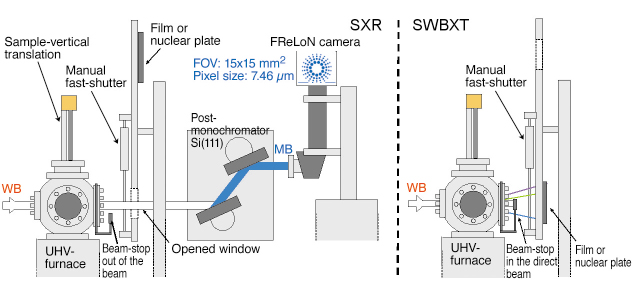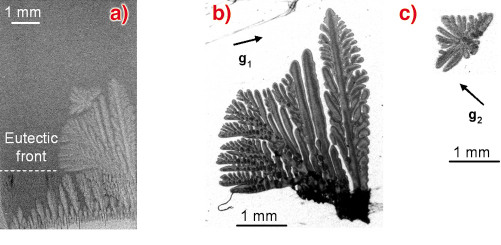- Home
- Users & Science
- Scientific Documentation
- ESRF Highlights
- ESRF Highlights 2006
- X-ray Imaging and Optics
- A new setup combining radiography and diffraction topography to study the solidification of Al-based alloys in situ
A new setup combining radiography and diffraction topography to study the solidification of Al-based alloys in situ
Material properties are primarily controlled by the microstructure built during the growth process. Beside their technological interest, understanding pattern formation at the solid-liquid interface is also a model case of self-organisation in systems out of thermodynamic equilibrium. Directional solidification is the key technique for studying the dynamical phenomena involved in microstructure formation under controlled conditions. In situ and real-time investigations are crucial to the clarification of the pattern dynamics. A unique experimental setup, allowing the combination of synchrotron X-ray radiography (SXR) and synchrotron white beam X-ray topography (SWBXT), has been developed at beamline ID19. These two imaging techniques provide complementary information. While radiography captures the evolution of microstructure morphology (shape, velocity of the growing interface) and solute segregation, topography provides crystallographic insight into the growing solid (orientation, strain field) and, in favourable cases, enables defect characterisation.
Upward solidification is performed inside a Bridgman furnace placed in an Ultra High Vacuum (UHV) chamber [1]. The thin Al-based alloy sample (37 x 6 x 0.2 mm3) is placed in a graphite crucible, mounted in a holder connected to a motorised translation stage. For in situ and real-time X-ray imaging (Figure 132), the main surface of the sample (37 x 6 mm2) is set perpendicular to the incident synchrotron X-ray white beam (WB). The transmitted beam is used for radiography. Radiographs are recorded using the FReLoN CCD-camera developed at the ESRF. Diffracted beams are used for topography. Topographs are recorded at will, discontinuously on high-resolution films (resolution 5 µm) or nuclear plates (resolution 1 µm) stored on a wheel placed after the UHV-chamber.
 |
|
Fig. 132: Schematic drawing of the experimental set-up developed at ID19 for the combined SXR-SWBXT investigation of Al-based alloy solidification. |
Alloy solidification from the melt often results in the growth of branching structures known as dendrites. Dendritic patterns play a critical role in the engineering of finished products with optimum properties by a wide range of solidification processes, such as casting [2] and welding. Therefore, dedicated experiments are timely. Microstructure formation and quality during the directional solidification of a model metallic alloy, Al - 3.5 wt% Ni, were analysed simultaneously for the first time (Figure 133). The radiographs (Figure 133a-c) show the development of the dendritic microstructure following the morphological instability of the smooth solid – liquid interface. We can see from the topograph in Figure 133d that the dendrites are of high quality in the early stage of their growth. Indeed, the equal-thickness fringes (see close-up) attest the absence of defects (dislocations: less than 10 cm/cm3) in the solid. Then, although nothing can be anticipated from the continuous evolution of the dendrite morphology in the radiographs, disorienting of dendrite parts begins (Figure 133e) and becomes exacerbated with time in the topographs (Figure 133f and g). In Figure 133e and f, the image of the secondary dendrite arm (circled in black) stays separated from the main stem due to mechanical bending, whereas the image of the dendrite top (circled in dashed blue), which moves away to the right following a rotation of about 0.1° around the dendrite axis, later comes back into position, which suggests an elastic behaviour. At later times (Figure 133g), the distortion field splits the image into many pieces, which makes the dendrite hardly recognisable.
 |
|
Fig. 133: Radiographs (a-c) and (-2-2 0)-topographs (d-g) recorded during the formation of a dendritic columnar microstructure. V = 1 µm/s, G ~ 30 K/cm. (a, d) t = t0 + 1574s, (b, e) t = t0 + 2461s, (c, f) t = t0 + 3253s. |
The strain level depends on the solidification process. For instance, in the case of dendritic growth by cooling the same sample at a rate of 0.5 K/min (Figure 134), high quality dendrites are observed even at sizes comparable to the largest in Figure 133 (see equal-thickness fringes in Figure 134b). Figure 134c shows that the equiaxed grain growing just above the columnar dendrite in the radiograph is equally perfect. It is worth noticing that this grain stopped the growth of the dendritic microstructure below it.
 |
|
Fig. 134: Al-3.5wt%Ni solidification: Radiograph of the sample (a), topographs of the columnar dendritic structure (b) and of the equiaxed grain (c). Images recorded 59 min 54s after the start of cooling. |
References
[1] H. Nguyen-Thi et al, J. Phys. D: Appl. Phys. 36, A83 (2003).
[2] J.A. Spittle, Int. Mater. Rev. 51, 247 (2006).
[3] B. Billia et al, Phys. Rev. Lett. 93, 126105 (2004).
Principal Publication and Authors
A. Buffet (a), G. Reinhart (b), T. Schenk (c), H. Nguyen-Thi (b), J. Gastaldi (d), N. Mangelinck-Noël (b), H. Jung (b), J. Härtwig (a), J. Baruchel (a), B. Billia (b), J. Phys. D: Appl. Phys., in press.
(a) ESRF
(b) L2MP, Université Paul Cézanne– Aix-Marseille III, Marseille (France)
(c) Ecole des Mines de Nancy (France)
(d) CRMCN, Campus Luminy, Marseille (France)



